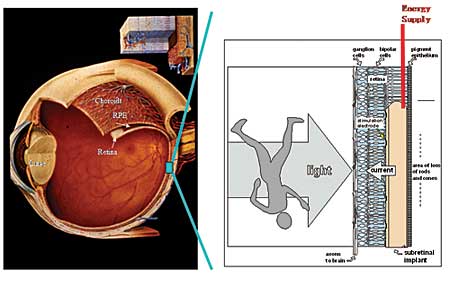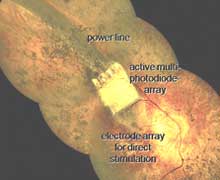Subretinal implant shows promise to restore vision in some patients
An external energy supply increases the prosthesis’ capacity to provide accurate neuronal stimulation.
VIENNA, Austria – A subretinal prosthesis that replaces the function of degenerated photoreceptors is showing encouraging results in blind patients.
The development of the implant from Retina Implant AG was undertaken by the German Federal Ministry of Education and Research in 1995 and involved five research institutes in Germany. After 10 years of basic research, the implant has now reached the stage of clinical testing.
“Seven patients underwent surgery without any intraoperative or postoperative complication. All of them tolerated the implant, which was kept in place for 30 days. A variable degree of visual perception was restored in all the patients but one,” said Eberhart Zrenner, MD, presenting the results of the first pilot study at the joint meeting of the European Society of Ophthalmology and American Academy of Ophthalmology.
 Positioning of the external supply. |  The subretinal implant for the clinical pilot study. Images: Zrenner E |
An active implant
The core of the implant is a microchip about 3 mm by 3 mm in size and 0.1 mm in thickness, containing about 1,500 light-sensitive photodiodes, amplifiers and electrodes, each generating a pixel. The microchip is connected to an external energy supply through a power line that is implanted subdermally.
“The electrical signals produced by the light on the implant are amplified by this source of energy, providing the appropriate quantity of neuronal stimulation. The signal will then be transmitted via bipolar and ganglion cells from the optic nerve to the brain,” said Dr. Zrenner, who is medical director at the Centre for Ophthalmology of Tübingen University and chairman of the supervisory board for Retina Implant AG.
Previous experimental “passive” subretinal implants relied on electricity generated by light as their only power source. They did not receive sufficient current to stimulate retinal neurons, and therefore there was no image transformation at the chip level.
“Our device is an ‘active’ implant, supported by external energy, with an increased capacity to provide accurate neuronal stimulation,” Dr. Zrenner said.
The implant can adapt to different ambient illumination levels, he said. Local contrasts are transformed into voltage amplitudes, which vary according to the strength of local illumination to each pixel.
|
|
Implantation technique
Implantation of the device requires a 5-hour operation, starting from behind the ear, where one end of the power line is clamped. The skin is tunnelized from this point to the upper fornix of the eye. A small scleral flap is then performed to uncover the choroid, and with the help of a guiding foil, the implant is slid under the retina. A small portion of the retina is preventively detached with a small bleb of fluid, which is eventually removed and replaced with silicone oil, Dr. Zrenner said.
“The chip is placed underneath the retina, exactly where in normal-sighted persons the light-sensitive photoreceptor cells are located,” he said. “Thus, we can be sure that the electric impulses emitted by the implant are really transmitted to the same nerve cells that in persons with a healthy retina receive information from the photoreceptors. In this manner, the natural information processing network is being used along the natural pathways.”
The pilot study included seven patients aged between 45 and 58 years. All were affected by some form of hereditary retinal degeneration, were blind for a variable number of years and had, earlier in life, a visual acuity of 20/200 or better.
A number of safety and efficacy tests were performed for 4 weeks after implantation.
What patients perceived
|
|
“Patients could perceive single phosphenes, described as round dots, yellowish or slightly gray with the approximate size of a pea, viewed at a distance of arm length. They disappeared in a pixelated manner,” Dr. Zrenner said.
Multiple phosphenes in a single row were described by patients as one continuous object about the size of a match, consisting of just-discernible dots with indentations between dots, he said.
Horizontal and vertical bars could be clearly detected.
“Patients were asked to turn a pencil in the vertical or horizontal position, according to the orientation of the stimulation pattern. About 86% of responses were correct,” Dr. Zrenner said.
Angles could be recognized as angles, although determination of the angle size was difficult for most patients. Parallel bars could not be recognized reliably, probably because of the too many electrodes switched at the same time, he said.
Direction of movement at a traveling speed of 2 Hz was easily detected, with 90% correct responses.
“We learned that brightness increases with the voltage of the stimulus. We asked the patients to categorize their perception in a relative scale from very bright to very dim and obtained a wide range of brightness. Interestingly, also the size of the bright spot was correlated with the stimulation strength. A brighter spot was perceived as larger,” Dr. Zrenner said.
Some patients were able to locate a white dinner plate against a dark tablecloth in dim light and to follow the movements of this object in various directions.
Future improvements
Although there were individual variations in the quantity and quality of perception, all patients were happy, Dr. Zrenner said.
“They said they would like to repeat the experiment, and that it was a great experience to be able to see light again. One of the patients didn’t want to have the chip explanted, and this long-term permanence in the eye is giving us important information on the biocompatibility of the device,” he said.
In the next series of patients, the effects of long-term implantation from 3 to 6 months will be evaluated.
“In the meantime, we are working to improve the spatial resolution, the energy supply and the stimulus transmission system,” Dr. Zrenner said.
For more information:
- Eberhart Zrenner, MD, medical director, Centre for Ophthalmology, and chairman of the supervisory board for Retina Implant AG, can be reached at Universitäts-Augenklinik Tübingen, Schleichsrasse 12-16, D-72076 Tübingen, Germany; +49-7071-2984786; fax: +49-7071-295038; e-mail: ezrenner@uni-tuebingen.de.
- The Retina Implant AG was developed by the Subretinal Consortium. Partners of the Consortium are:
- University Eye Hospital Tübingen (E. Zrenner, K. Bartz-Schmidt, D. Besch, F. Gekeler, C. Kuttenkeuler, R. Wilke)
- Steinbeis-Transfer-Centre for Biomedical Optics and Function Testing, Tübingen (B. Wilhelm, T. Peters)
- University Eye Hospital Regensburg (V.P. Gabel, H. Sachs, K. Kobuch, Fr. Brunner)
- Natural and Medical Science Institute (H. Hämmerle, W. Nisch, M. Stelzle, A. Stett)
- Retina Implant AG, Reutlingen (A. Harscher, A. Meine, S. Heim, U. Greppmeier, W. Wrobel)
- Institute for Microelectronics, Stuttgart (H.G. Graf, M. Graf, B. Höfflinger)
- Retina Implant AG can be reached at Gerhard-Kindler-Straße 8, 72770 Reutlingen, Germany; +49-7121-36403-0; fax: +49-7121-36403-15; Web site: www.eye-chip.com.
- Michela Cimberle is an OSN Correspondent based in Treviso, Italy, who covers all aspects of ophthalmology. She focuses geographically on Europe.


